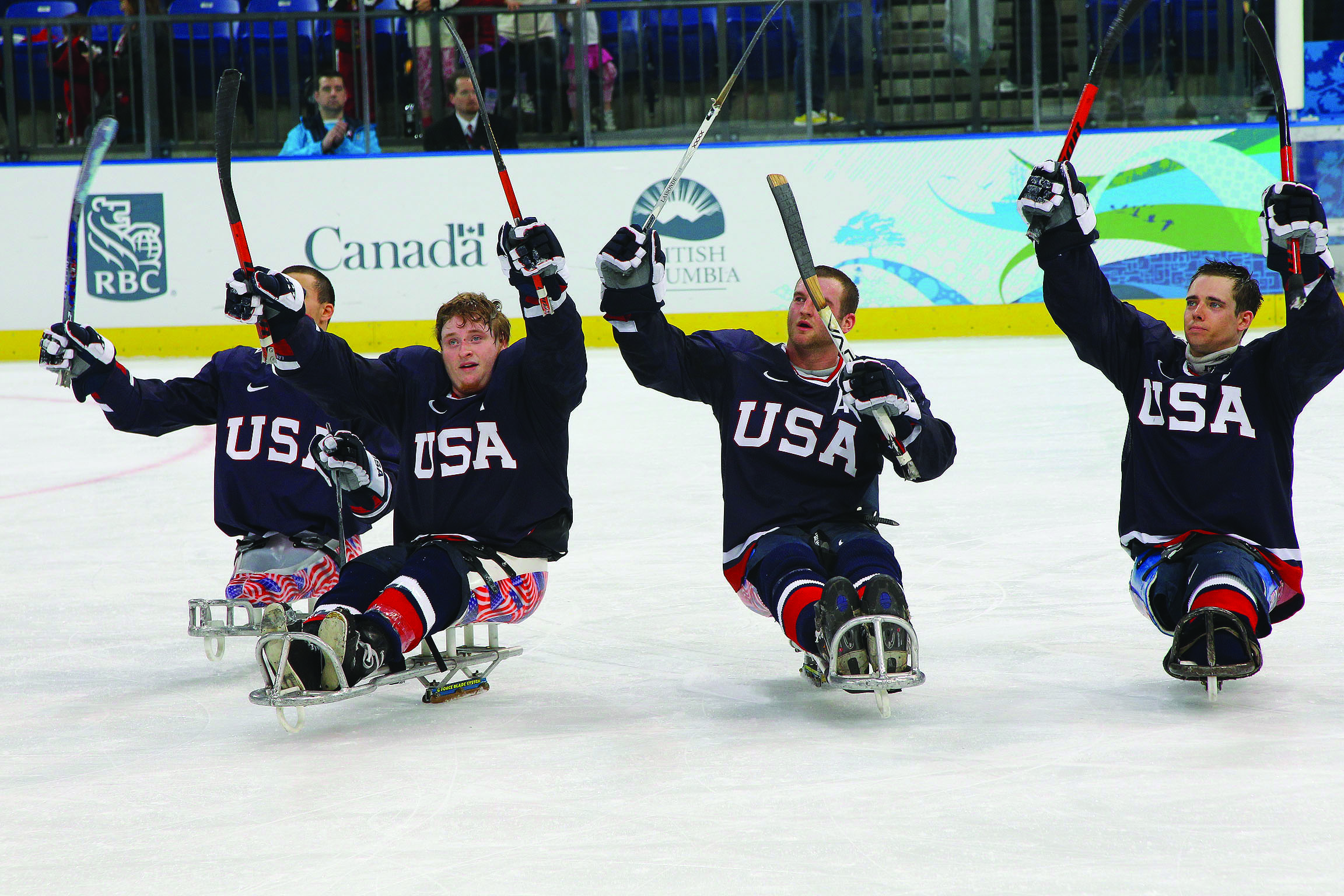
The popularity of sled hockey is on the rise.
Many DSUSA chapters offer sled hockey opportunities, as do other independent clubs across the country. The sport received a huge boost when USA Hockey took over as the national governing body for sled hockey and sled hockey programs. For the past 10 years, USA Hockey-sponsored sled hockey programs have sprung up across the U. S., with the national team selected by the organization. Also fueling interest in the sport is the National Hockey League (NHL), which hosted the first USA Hockey Sled Classic in Littleton, Colo., and Denver this past October. Four teams made up of 46 players, many on current and recent U.S. national team rosters, played under their NHL affiliate’s jersey – Colorado Avalanche, Chicago Blackhawks, Philadelphia Flyers, and Pittsburgh Penguins. Organizers hope to ultimately have all 32 NHL teams represented in future Sled Classics. And let’s not forget the U.S. Sled Hockey team which won gold in the 2010 Paralympic Winter Games in Vancouver. Amputee goalie Steve Cash, who didn’t allow a single goal in five games, won an ESPN ESPY award for Best Male Athlete with a DisAbility.
Who Can Play
Sled hockey is played by a wide range of players with a variety of mobility limitations: amputees, spinal cord injuries, spina bifida, along with anyone who has a permanent disAbility that limits participation in stand up hockey. In addition, with the exception of the highest level of competition, non-disAbled players are encouraged to participate.
“To play sled hockey, the only requirement is that you have a disAbility that prohibits you from playing stand up. That makes it very broad,” said Tom Carr, CTRS/L, assistant director of outreach and athletics, at Northeast Passage.
Northeast Passage, DSUSA’s Chapter in New Hampshire, has a thriving sled hockey program that attracts as many as 200 participants throughout the winter season. “As a team sport, it’s one of the fastest growing,” Carr said.
Part of its appeal is that there is little difference between sled hockey and stand up hockey in how the game is played. “It’s fast-paced and a full contact sport. The main difference is it’s played on a sled,” he said.
Sled hockey is a great form of exercise and fitness. It increases strength and coordination and also conditions the upper body. The balance used to propel, play the puck, and turn and stop gives arms, back and abdominal muscles a workout. Those who play regularly quickly notice an increase in overall strength and balance both on and off the ice.
Necessity is the Mother of Invention
Sled hockey had its beginning in the early 1960s when some enterprising athletes at a physical rehabilitation center in Sweden wanted to play the game. The men modified a metal frame sled with two regular-sized ice hockey skate blades that allowed the puck to pass underneath. Their hockey sticks were round poles with bike handles.
The growth of the sport was slow to develop but by 1969, Stockholm had a five-team league that included both disAbled and able-bodied players. Ice sled hockey was first demonstrated at the Paralympic Winter Games in Sweden in 1976, and then again at the 1988 Innsbruck Paralympics. It became an official event at the 1994 Lillehammer Paralympics.
The game and equipment
Unless there is a penalty, there are six players for each team – three forwards, two defensemen, and a goalie. Substitutes may be made when play is stopped, or on the fly. Previously, periods were 15 minutes in length, but this year they have been increased to 20 minutes, the same as stand up hockey. Play is on a regulation sized ice rink with standard size nets and puck. Checking and high-speed slapshots are common features of the sport.
Carr noted that sled hockey players typically own their own sleds for the best customized fit. “Once someone gets into the sport, they want and need their own equipment,” he said. Players can get a basic hockey sled and pair of sticks for (approximately) $1,000.
Sleds are usually made of light-gauge aluminum, consisting of a customized “bucket” to sit in. A backrest can be used depending on the ability of the athlete. A frame supports the bucket, legs and feet, and is mounted on two skate blades attached under the bucket. Athletes with double amputations tend to have an advantage here, since they can use shorter sleds with no leg supports, resulting in a smaller turn radius.
Instead of one hockey stick, players use two for propulsion, passing and shooting. The sticks may be up to 100 cm long but are usually between 75-95 cm and can be wood, aluminum, or composite materials. The sticks have metal picks on one end for players to propel themselves.
“It helps if you have decent upper body strength and hand grip, but even then there are modifications and adaptations that can be made,” Carr said. “Even those with limited grip can have sticks secured to their hands allowing them to participate.”
Players are outfitted with a hockey helmet, gloves, and body protection. Goalies wear basically the same equipment but do make modifications to the glove; metal picks are attached to the backside allowing the goalie to maneuver.
Sled hockey has a relatively small number of equipment suppliers to provide the sleds, sticks and picks that are unique to sled hockey. All other hockey equipment that is necessary such as helmets, gloves, etc. can be bought from any other stand up hockey equipment supplier.

